Determining CBD Dosage: A Step-by-Step Guide
Written by California Blendz
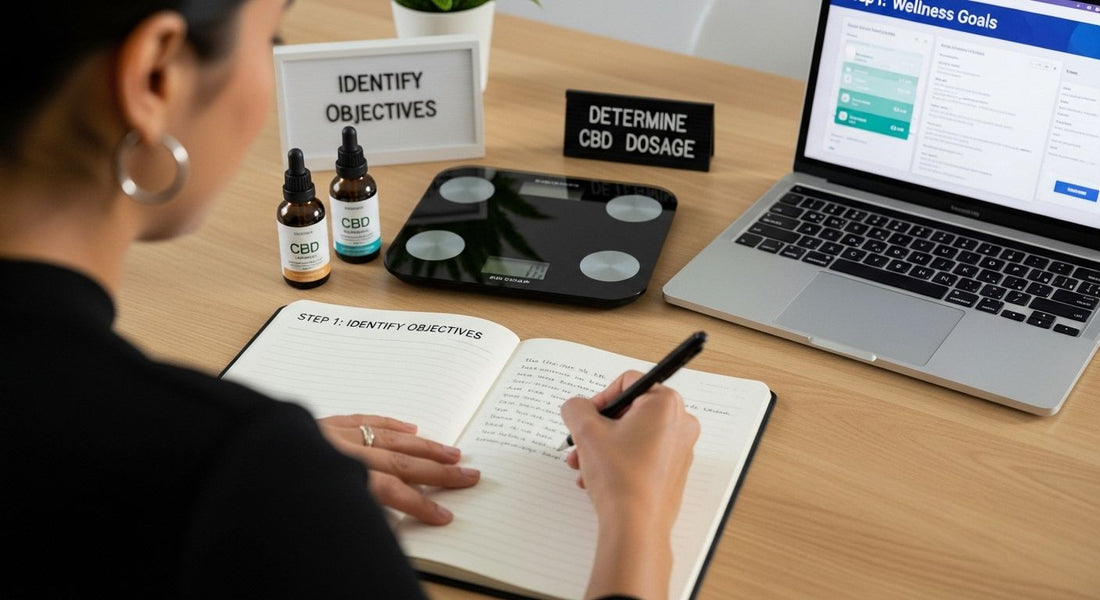
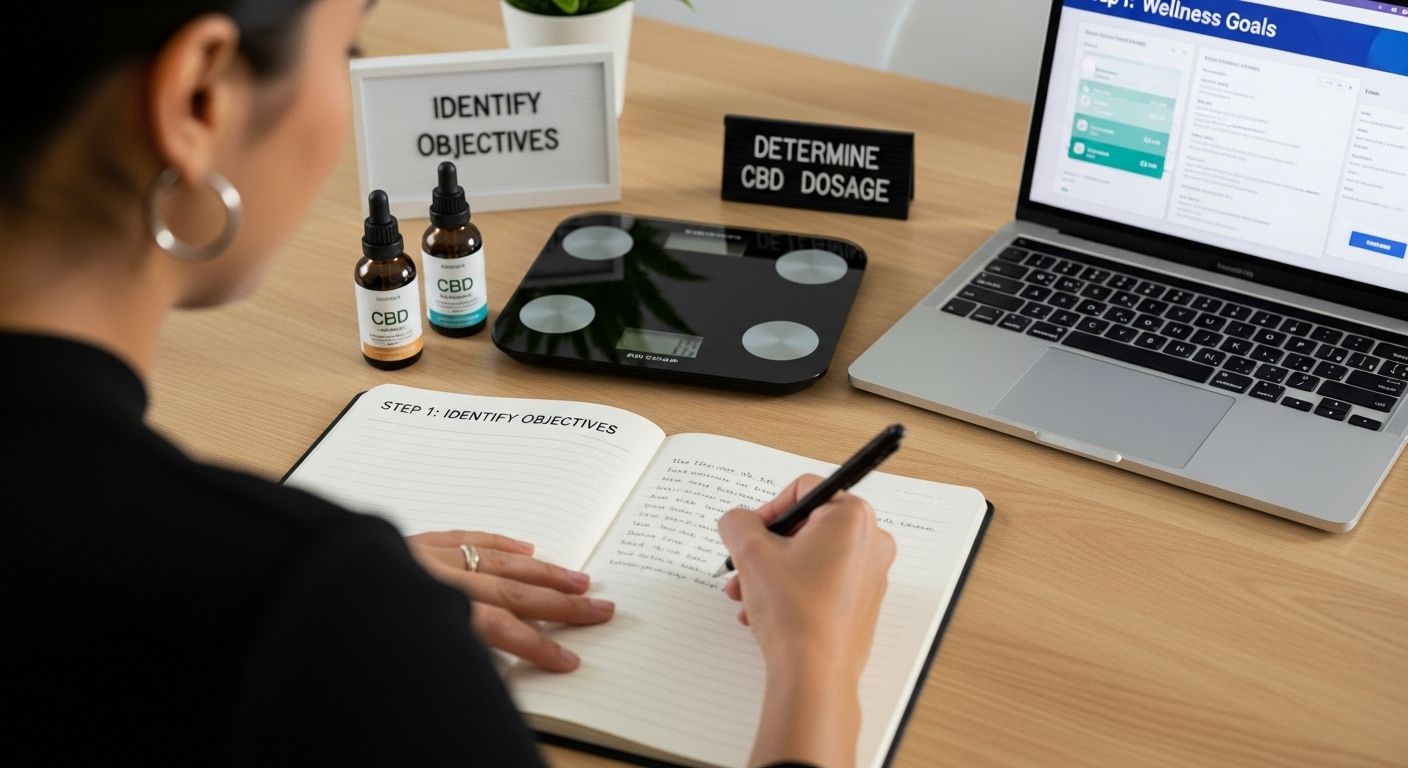
Finding the right CBD dosage can feel confusing because everyone’s body responds differently. And check this out. The recommended starting point is only 1-6 mg of CBD per 10 pounds of body weight, meaning a 150-pound person could need anywhere from 15 to 90 mg just to see what works. That wide range surprises most people, but it actually puts you in control. By personalizing your approach step by step, you can avoid wasted time and finally unlock the benefits you’re hoping for.
Table of Contents
- Step 1: Identify Your Objectives For CBD Usage
- Step 2: Calculate Your Ideal Dosage Based On Body Weight
- Step 3: Choose Your CBD Product Type For Precise Dosing
- Step 4: Start With A Low Dose And Gradually Adjust
- Step 5: Monitor Effects And Fine-Tune Your Dosage
- Step 6: Document Your Experience For Future Reference
Quick Summary
| Key Point | Explanation |
|---|---|
| 1. Define Your CBD Objectives | Establish specific health goals to guide your CBD usage and dosage decisions. |
| 2. Calculate Dosage by Weight | Start with a weight-based dosage of 1-6 mg per 10 pounds to ensure a tailored approach. |
| 3. Choose the Right Product Type | Select a CBD format, such as tinctures or capsules, that offers precise dosing for your needs. |
| 4. Start Low and Adjust Gradually | Begin with a low dose and increase it incrementally based on your body’s response after careful observation. |
| 5. Document and Monitor Effects | Keep detailed records of dosages and effects to identify trends and optimize your CBD strategy over time. |
Step 1: Identify Your Objectives for CBD Usage
Determining your specific objectives for CBD usage is a crucial first step in establishing an appropriate dosage strategy. Unlike many wellness products, CBD interacts uniquely with each individual’s endocannabinoid system, making personal goals and expectations fundamental to your approach.
Begin by conducting an honest self-assessment of your wellness needs. Are you seeking relief from chronic pain, managing anxiety symptoms, improving sleep quality, or addressing inflammation? Each objective requires a nuanced understanding of how CBD might potentially support your specific health goals. The potential performance considerations of CBD can vary significantly based on your intended outcomes.
Clinical research suggests different conditions might respond differently to cannabinoid interventions. For instance, individuals targeting anxiety might require a different dosage approach compared to those managing physical discomfort. Your objectives will directly influence not just dosage, but potentially the type of CBD product most suitable for your needs.
Consider documenting your specific wellness objectives with precise, measurable criteria. This means moving beyond vague statements like “I want to feel better” to concrete goals such as “reduce nighttime anxiety episodes” or “decrease lower back pain intensity by 50%”. Quantifiable objectives allow you to track progress and adjust your CBD strategy more effectively.
Remember that consulting with a healthcare professional can provide personalized insights tailored to your unique physiological profile. They can help validate your objectives and recommend an initial approach that considers your medical history, current medications, and specific health considerations.
Successful CBD usage begins with clarity of purpose. By precisely defining your wellness objectives, you create a solid foundation for determining an appropriate and personalized CBD dosage strategy.
Here is a step overview table summarizing the main actions in the CBD dosage determination process, including their purpose and key outcomes.
| Step | Purpose | Key Outcome |
|---|---|---|
| Define Your Objectives | Clarify specific wellness goals | Personalized starting point |
| Calculate Dosage by Weight | Determine initial dosage range | Scientifically grounded starting dose |
| Choose the Right Product Type | Select format for accurate dosing | Consistent CBD intake |
| Start Low and Adjust Gradually | Allow body adaptation and minimize side effects | Safe titration to ideal dose |
| Monitor Effects and Fine-Tune Dosage | Observe and optimize effectiveness | Ongoing optimization |
| Document Your Experience | Track data for future reference | Long-term improvement and learning |
Step 2: Calculate Your Ideal Dosage Based on Body Weight
Calculating your ideal CBD dosage based on body weight provides a scientifically grounded starting point for your wellness journey. Unlike one-size-fits-all approaches, weight-based dosing recognizes that individual metabolic differences significantly impact how your body processes cannabinoids.
To begin, you’ll need a precise measurement of your current body weight. Use a digital scale for accuracy, and record your weight in pounds or kilograms. The standard recommendation is to start with 1-6 mg of CBD per 10 pounds of body weight, depending on your desired effect intensity and individual tolerance. For example, a 150-pound individual might begin with 15-90 mg of CBD per dose.
The calculation process involves simple multiplication. Take your total body weight and multiply it by 0.1 to 0.6, which represents the low to moderate dosage range. Understanding potential CBD performance factors can help you make more informed decisions about where you fall within this range.
Individuals with more severe symptoms or higher wellness goals might lean toward the upper end of the dosage spectrum, while those seeking mild support should start at the lower end. Your body weight provides a baseline, but factors like metabolism, existing health conditions, and individual endocannabinoid system sensitivity will ultimately influence your ideal dosage.
Critical considerations include starting low and incrementally increasing your dosage. Begin with the lowest calculated amount and observe your body’s response over several weeks. Pay attention to how you feel, tracking any changes in your target symptoms or overall wellness. This methodical approach allows you to find your personal sweet spot without overwhelming your system.
If you have any pre-existing medical conditions or are taking other medications, consulting with a healthcare professional becomes even more crucial. They can provide personalized guidance that takes into account your unique physiological characteristics and potential interactions with other treatments.
Remember, weight-based dosing is a starting point, not a definitive prescription. Your body’s response and individual wellness goals will ultimately guide your final CBD dosage strategy.
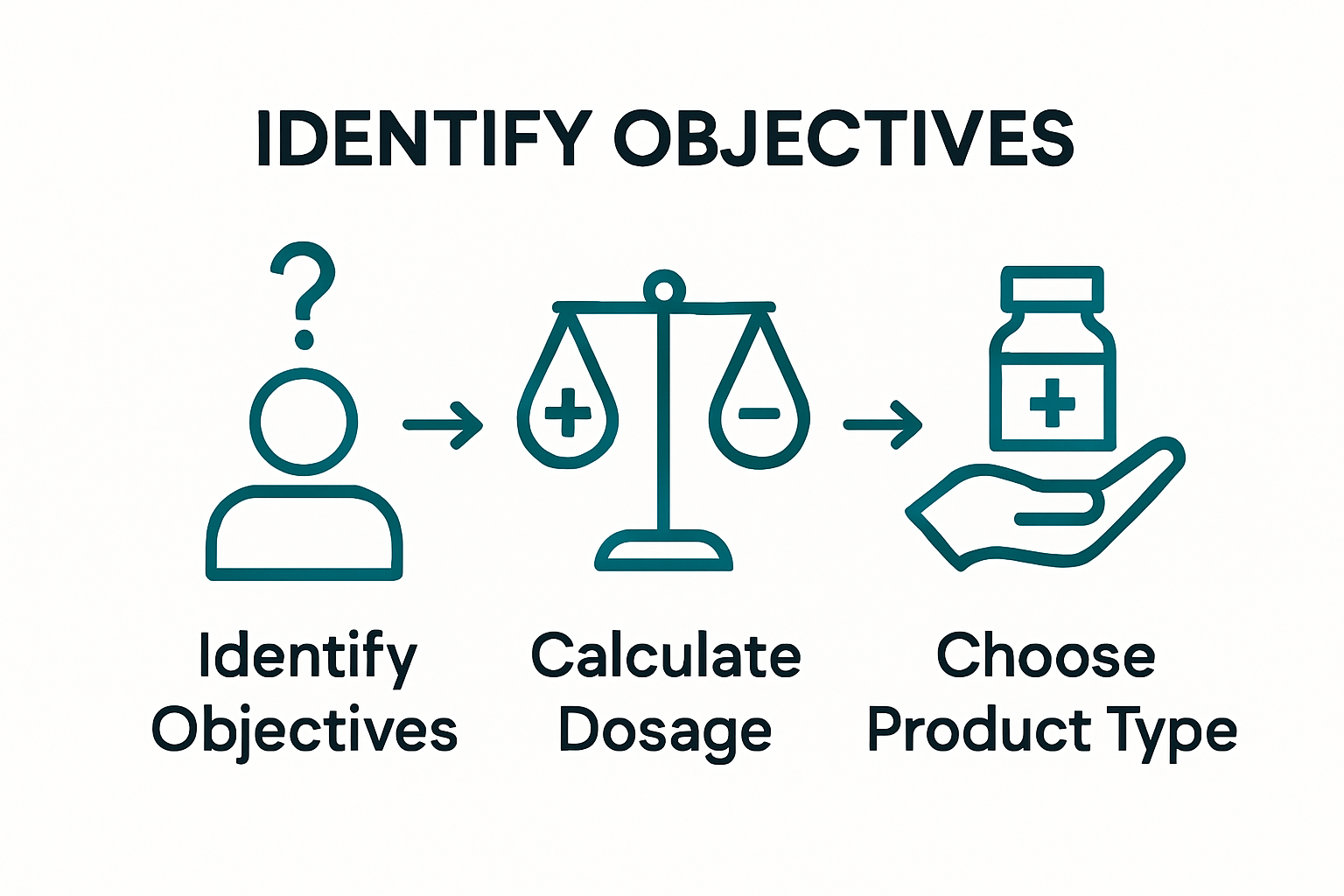
Step 3: Choose Your CBD Product Type for Precise Dosing
Selecting the right CBD product type is critical for achieving precise and consistent dosing. Different product formats offer varying levels of dosage control, absorption rates, and onset times, making your selection a pivotal decision in your CBD wellness journey.
Tinctures represent the gold standard for dosage precision. These liquid extracts typically come with calibrated droppers, allowing you to measure exact milliliter quantities. By understanding performance nuances, you can optimize your tincture experience. Most tinctures clearly label milligrams per milliliter, enabling straightforward mathematical calculations to match your targeted dosage.
Capsules and softgels offer another highly controlled dosing method. Each capsule contains a predetermined amount of CBD, eliminating guesswork associated with other delivery methods. This approach is ideal for individuals who prefer consistent, measured doses and dislike the taste of traditional tinctures. The standardized nature of capsules means you can easily track your exact daily intake without complex measuring procedures.
Topical products like creams and balms present unique challenges for precise dosing. While excellent for localized relief, these products absorb differently across skin types and cannot be as precisely measured as oral formats. If you choose topicals, look for products with clear concentration labels and start with small applications, gradually increasing based on your body’s response.
Vaping and inhalation methods provide rapid absorption but introduce significant dosage variability. The amount of CBD delivered depends on factors like inhalation depth, duration, and individual lung capacity. Beginners should exercise extreme caution with these methods and potentially consult healthcare professionals for guidance.
When choosing your product, consider additional factors beyond dosage precision. Bioavailability, or the rate at which CBD enters your bloodstream, varies dramatically between product types. Tinctures taken sublingually typically offer faster and more complete absorption compared to capsules or edibles.
Remember that no single product type works perfectly for everyone. Your ideal choice depends on your specific wellness objectives, lifestyle preferences, and individual physiological responses. Start with the most precise method possible, track your results meticulously, and be prepared to adjust your approach as you learn more about your body’s unique interaction with CBD.
Below is a comparison table of different CBD product types, highlighting their dosage precision, absorption rate, and best use cases to help guide your product selection.
| Product Type | Dosage Precision | Absorption Rate | Best Use Case |
|---|---|---|---|
| Tinctures | High | Fast (sublingual use) | Flexible, precise dosing |
| Capsules | High | Medium | Consistent, easy, taste-free dosing |
| Topicals | Low | Variable (skin type) | Localized relief for specific areas |
| Vapes | Low/Variable | Fast (inhalation) | Rapid onset, less precise measurement |
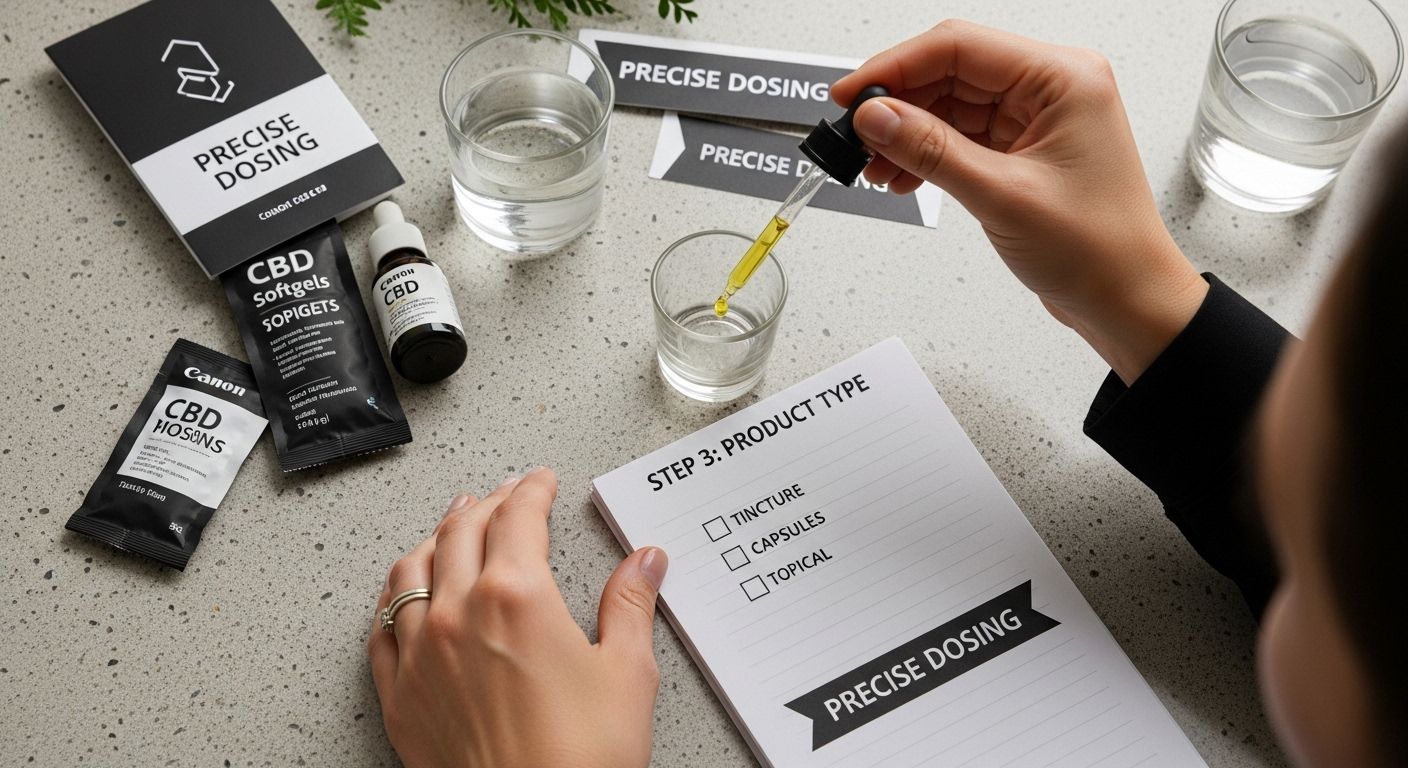
Step 4: Start with a Low Dose and Gradually Adjust
Starting with a low CBD dose and incrementally adjusting represents the most prudent approach to finding your optimal wellness balance. This methodical strategy allows your body to acclimate to cannabinoids while minimizing potential side effects and providing valuable insights into your individual response.
Begin with the lowest recommended dose based on your body weight calculation. For most individuals, this means starting at approximately 5-10 mg daily. Understanding potential performance variations can help you navigate this initial phase more effectively. Think of this process as a personal experiment where you are the primary researcher, carefully observing how your body responds to incremental changes.
Document your initial dosage, timing, and any perceived effects in a dedicated journal or digital tracking app. Pay close attention to subtle changes in your target symptoms, energy levels, sleep quality, and overall wellbeing. Some individuals might notice immediate effects, while others require several weeks of consistent use to experience noticeable results.
Increase your dosage gradually, typically by 5-10 mg every one to two weeks. This slow titration allows your endocannabinoid system to adjust and provides clear insights into how each dosage increment impacts your body. Watch for both positive changes and potential side effects, which might include drowsiness, dry mouth, or minor digestive shifts. These signals help you fine-tune your approach.
Consider timing and consistency critical components of your CBD journey. Take your doses at the same time daily to establish a reliable baseline. Morning users might focus on energy and focus, while evening users often prioritize relaxation and sleep support. Your chosen timing can significantly influence your overall experience and effectiveness.
Remember that individual biochemistry varies dramatically. What works perfectly for one person might require complete recalibration for another. Patience and meticulous observation are your greatest allies in determining your ideal CBD dosage. If you experience persistent side effects or no discernible benefits after several weeks of careful adjustment, consulting a healthcare professional becomes an important next step.
Ultimately, finding your perfect CBD dosage is a personal journey of self-discovery. Approach it with curiosity, patience, and a commitment to listening to your body’s unique signals.
Step 5: Monitor Effects and Fine-Tune Your Dosage
Monitoring your CBD journey transforms a simple supplementation routine into a personalized wellness strategy. This critical step involves carefully tracking your body’s response, identifying subtle shifts, and making informed adjustments to optimize your experience.
Create a comprehensive tracking system that goes beyond basic symptom observation. Learn about potential performance factors to enhance your monitoring approach. Develop a detailed log documenting daily dosage, time of consumption, specific symptoms, energy levels, sleep quality, and any noticeable physiological or emotional changes. Digital health apps or a dedicated journal can help you maintain consistent, objective records.
Pay attention to both positive and negative responses. Beneficial effects might include reduced anxiety, improved sleep, decreased inflammation, or enhanced overall relaxation. Conversely, be alert to potential side effects such as drowsiness, dry mouth, changes in appetite, or mild digestive discomfort. These signals provide crucial information about how your body processes and responds to CBD.
Establish a realistic evaluation timeline. Most individuals require 4-6 weeks of consistent use to understand their body’s complete response to CBD. During this period, resist the urge to make frequent, dramatic dosage changes. Instead, implement gradual adjustments, typically increasing or decreasing by 5-10 mg increments every two weeks.
Consider external factors that might influence your CBD experience. Stress levels, diet, exercise, sleep patterns, and concurrent medications can all impact how your body interacts with cannabinoids. A holistic approach means examining these interconnected elements rather than viewing CBD in isolation.
If you’re not experiencing desired results after 6-8 weeks of consistent, carefully monitored use, it might be time to consult a healthcare professional. They can provide personalized insights, rule out potential interactions, and help you refine your approach based on your specific health profile.
Remember that CBD is not a one-size-fits-all solution. Your ideal dosage is a dynamic target that may shift with changes in your health, lifestyle, and wellness objectives. Approach this journey with patience, curiosity, and a commitment to understanding your body’s unique responses.
Step 6: Document Your Experience for Future Reference
Documenting your CBD journey transforms a personal experiment into a valuable wellness roadmap. By creating a comprehensive, systematic record, you’ll gain insights that extend far beyond your immediate experience, potentially helping future treatment decisions and understanding your body’s unique cannabinoid response.
Establish a structured documentation system that captures nuanced details of your CBD experience. Explore potential performance insights to enhance your tracking methodology. Choose a method that feels intuitive and sustainable—whether a dedicated digital health app, a physical journal, or a spreadsheet. Consistency is key to generating meaningful data about your CBD usage.
Your documentation should include specific, measurable information. Record precise details such as:
- Daily CBD dosage (in milligrams)
- Time of consumption
- Product type and batch/lot number
- Specific symptoms or wellness objectives
- Subjective rating of effectiveness (1-10 scale)
- Any concurrent lifestyle factors (sleep, diet, stress levels)
- Noticeable side effects or unexpected responses
Capture not just numerical data, but qualitative experiences. Describe how you feel beyond simple symptom reduction. Are you experiencing improved mood, enhanced focus, or more restful sleep? These nuanced observations provide context that pure numbers cannot convey.
Consider creating visual representations of your data. Graphs or charts tracking symptom intensity, sleep quality, or anxiety levels can reveal patterns that might be less obvious in written text. Many digital health apps offer automatic visualization tools that can transform your raw data into meaningful insights.
Review your documentation periodically—perhaps monthly—to identify trends and make informed adjustments. Look for correlations between dosage, timing, and your overall wellness. This reflective practice turns your CBD journey into a continuous learning experience, allowing you to become increasingly precise in your approach.
Ultimately, your documentation serves multiple purposes. It provides a personal reference for future CBD use, offers valuable information for healthcare professionals, and contributes to your broader understanding of how cannabinoids interact with your unique physiological system. Treat this process as a form of self-care and scientific exploration.
Find Your Personalized CBD Dosage with Confidence
Determining your ideal CBD dosage can seem overwhelming, especially when you want to target specific goals like relieving stress, improving sleep, or managing discomfort. As outlined in our guide, finding the right dosage means carefully tracking your body’s responses, considering your unique wellness objectives, and choosing products that let you dose with precision. Many readers feel unsure where to start or struggle to find products that fit their personal dosing strategies or deliver consistent results.
Explore CBD Flower for easy, reliable dosing that aligns with each step in your routine. Every product on California Blendz is organic, lab-tested, and designed to make your experience as transparent and stress-free as possible.
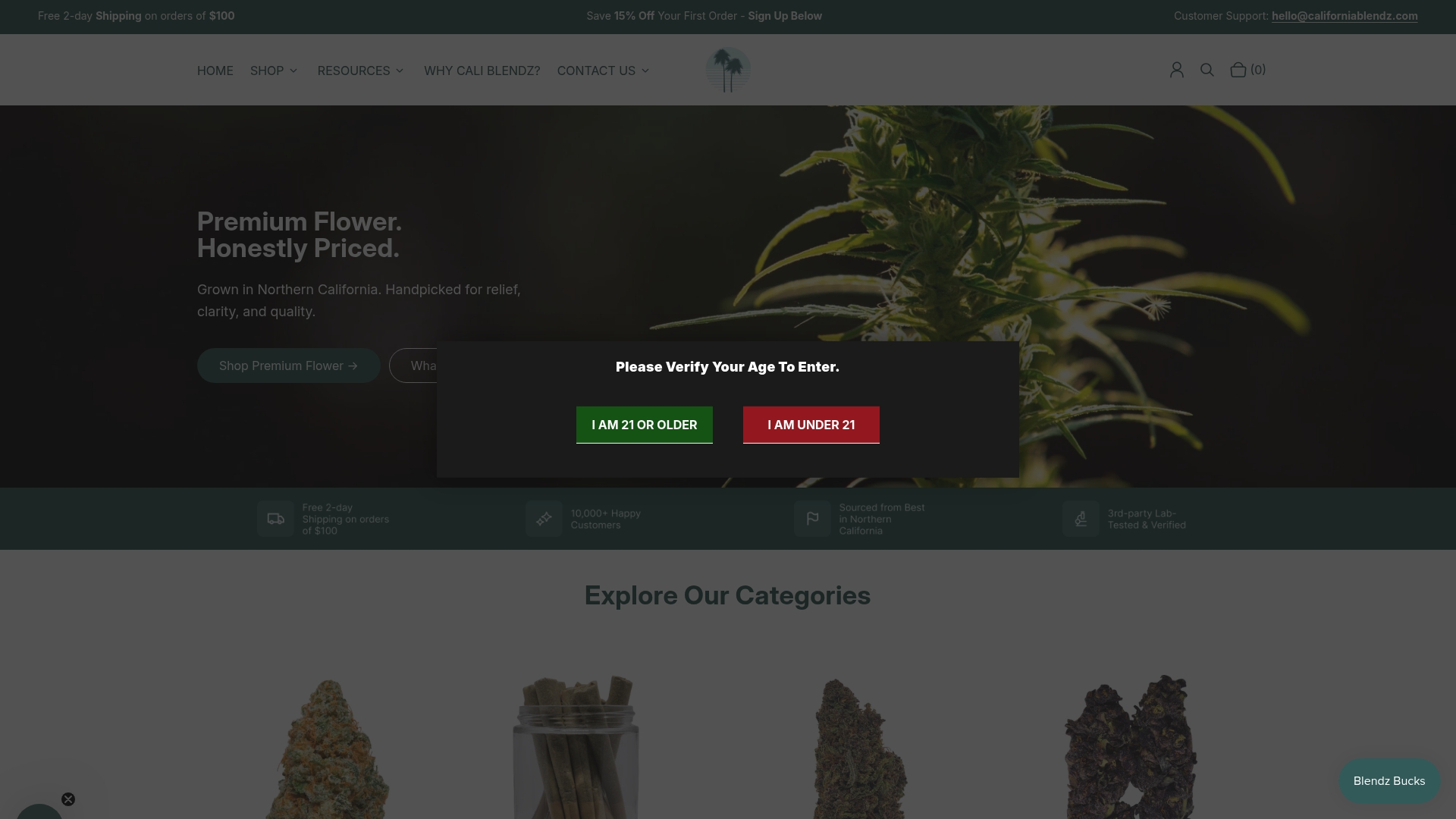
Ready to take the guesswork out of CBD? Shop our curated selection and find a product that fits your needs today. Begin your wellness journey with the peace of mind that comes from knowing exactly what you are taking. Visit California Blendz and find your best-fit CBD solution right now.
Frequently Asked Questions
What is the recommended starting dosage for CBD based on body weight?
To calculate your starting dosage, consider taking 1-6 mg of CBD per 10 pounds of body weight. For example, if you weigh 150 pounds, you might begin with a dosage range of 15-90 mg.
How should I choose a CBD product for accurate dosing?
Selecting products like tinctures or capsules allows for precise dosing. Tinctures typically come with calibrated droppers, while capsules have predetermined amounts. Avoid products with inconsistent dosing like topicals for exact measurements.
How do I adjust my CBD dosage over time?
Start with the lowest recommended dose and gradually increase it by 5-10 mg every one to two weeks, monitoring how your body responds throughout the process. This slow titration helps prevent overwhelming your system and allows you to find your optimal dosage.
What factors should I consider when monitoring my effects from CBD?
Pay attention to both positive effects, such as reduced anxiety or improved sleep quality, and any potential side effects like drowsiness. Consider lifestyle factors like diet and stress, and document your experiences to help identify trends over time.
Recommended
- A Step-by-Step Guide: How to Make CBD Infused Oil at Home – California Blendz
- All about CBD and cannabis high dosage and low dosage – California Blendz
- Understanding the Relationship Between CBD Flavor Profile and CBD Perc – California Blendz
- 3 Top Reasons Your CBD Might Be Under-Performing – California Blendz








